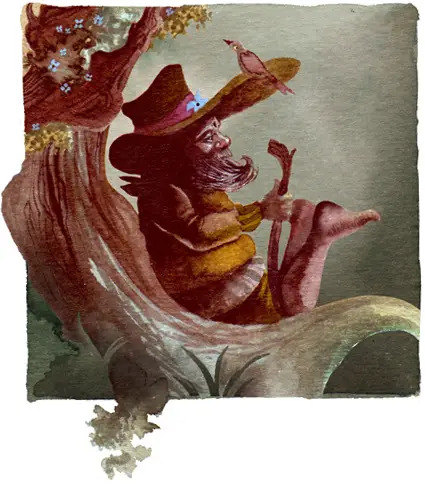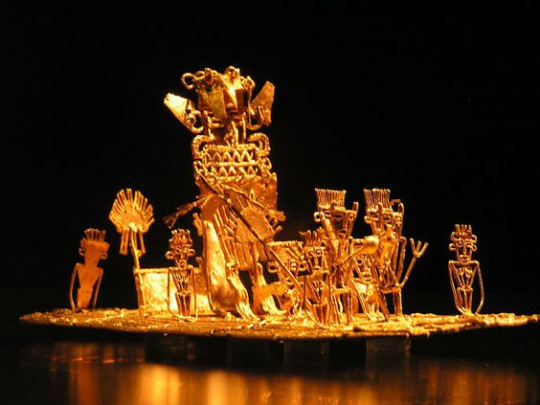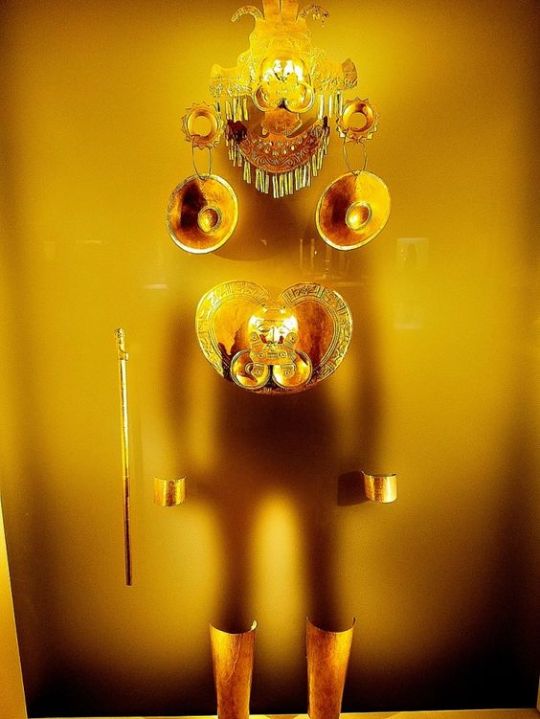#mestizo
Text
Me: You're mestizo
Mom: Correct
Me: And you've expressed sadness about how your indigenous father hid all his roots out if fear of being socially shunned and feel a disconnect
Mom: Correct
Me: So you understand that erasing culture is a form of genocide
Mom: Yes
Me: So do you agree that defending your culture from erasure and bastardization is a worthy goal and that we should do that?
Mom: No, I think we should submit to our conquerors and just lay down to die as they massacre us cause if we're submissive enough, they won't kill us...
Me: *screams in frustration*
11 notes
·
View notes
Photo

Patricia Velásquez
Gender: Female
Sexuality: Lesbian
DOB: 31 January 1971
Ethnicity: Mestizo, Indiginous Venezuelan (Wayuu)
Nationality: Venezuelan
Occupation: Model, actress
#Patricia Velásquez#Patricia Velasquez#lesbianism#sapphic#lgbtq#female#lesbian#1971#Mestizo#Venezuelan#indigenous#native#poc#biracial#model#actor#Remember Anck-su-namun in The Mummy? She’s gay.
95 notes
·
View notes
Text
Multiracial Flag

It can represent biracial, triracial, and among other people of mixed races. Multiraciality represents having multiple racial identities in one's ancestry.
There are other words that describes this.
#multiracial flag#interracial#interacial#biracial#triracial flags#quadracial#quadriracial#mixed race#mulatto#mulatte#mulatta#racial identity#raceness#race-ness#races#vexillology#vexillography#mestizo#mestiza#mestize#mestizx#mulattx#polyracial#poliracial#pluriracial#multi-raciality#bi-racial
9 notes
·
View notes
Text
the family lineage is so complicated too like .okay so allegedly id be mexican (on moms side) but then sometimes she will tell people we are spanish but when i ask shes like actually our oldest known great grandparents were new mexican and pueblo and also part of the family on her dads side i think are actually from the san juan valley but then shes like oh i just found out we might actually go all the way back to basque country. but the family records book says mexican all the way down. and last time we talked she said im mostly mexican + pueblo. so who even knows. and then thats not even mentioning MY dads side who are german. or czech. its confusing. something wrong with me
2 notes
·
View notes
Text
She [the mestiza] puts history through a sieve, winnows out the lies, looks at the forces that we as a race, as women, have been a part of. Luego bota lo que no vale, los desmientos, los desencuentros, el embrutecimiento. Aguarda el juicio, hondo y enraizado, de la gente antigua. This step is a conscious rupture with all oppressive traditions of all cultures and religions. She communicates that rupture, documents the struggle. She reinterprets history, and using new symbols, she shapes new myths. She adopts new perspectives toward the darkskinned, women and queers. She strengthens her tolerance (and intolerance) for ambiguity. She is willing to share, to make herself vulnerable to foreign ways of seeing and thinking. She surrenders all notions of safety, of the familiar. Deconstruct, construct. She becomes a nahual, able to transform herself into a tree, a coyote, into another person. She learns to transform the small "I" into the total Self. Se hace moldeadora de su alma. Segun la concepción que tiene de sí misma, así será.
— Gloria Anzaldúa, "La conciencia de la mestiza: Towards a new consciousness."
Follow Diary of A Philosopher for more quotes!
#lit#literature#quote#quotes#gloria anzaldua#colonialism#native american#mestizo#mestiza#philosophy quote#philosophy quotes#philosophy#feminist#feminist philosophy#queer theory#intersectional feminism#dark academia#light academia#latine#latin#latin america#south america#central america
4 notes
·
View notes
Text
I miss a land i never set foot on
I miss a tongue i never spoke
I miss my culture never taught
I miss not being katipunan
Or loving and living lives
Not spent in capitalist waste
11 notes
·
View notes
Text

Perro mestizo o "quiltro" esperando a su dueño en una fría mañana de otoño sobre una tapa de metal tibio.
Conchalí, Santiago de Chile, mayo 2023.
10 notes
·
View notes
Text
Tata Duende
The Tata Duende or El Dueño del Monte is a supernatural creature appearing in cultural folklore stories, mostly evident in Mayan and Mestizo cultures. The Tata Duende is considered a powerful spirit that protects animals and the jungle. There are many stories that have been passed on from generation to generation, to warn against this mischievous spirit.

This creature has appeared on a postage stamp of Belize as part of a series on Belizean folklore. The name Tata Duende comes from the Yucatec Maya word "Tata" meaning Grandfather or old and the word "Duende" is Spanish for goblin. The Spanish term duende originated as a contraction of the phrase dueño de casa or duen de casa, "possessor of a house", and was originally conceptualized as a mischievous spirit inhabiting a house. In Yucatec Maya the Tata Duende is known as Nukuch Tat.
The Tata Duende is a famous folklore common to the Maya culture and the Mestizo culture. According to different stories, The Tata Duende " is well known for luring children into the jungle, therefore, the Tata Duende has been used to scare children into behaving. Farmers would blame the Tata Duende if weird things happened on the farm. For example: it was common to see a horse's mane braided and it is claimed that these braids would be difficult to loose, sometimes it had to be cut. The true origin of the 'Tata Duende' seems to be quite unclear since many countries may have similar descriptions but different names. However, the term 'Tata Duende' seems to be coined in the Belizean folklore. Between the Yucatec Maya of Belize the Tata duende is known as Nukuch Tat or Tata Balam, it is seen as a good Maya guardian spirit of the forest, animals and humans. The Yucatec Maya of Belize continue giving offerings to the Tata duende for protection and for their help .
People who claimed to have seen the 'Tata Duende' said he was about 3 feet tall and wore a wide brimmed hat. Sometimes he wore a red hat and animal skin for clothing. He is also described as having his feet pointing backwards and his thumbs missing. Parents would tell their children that if they ever came across this creature to hide their thumbs or the Duende would bite it off. Some stories of people who have encountered the 'Tata Duende' say that they could recognize him because of his distinct whistle. Others say that he smokes cigars and plays the guitar.
here are many stories warning people to be cautious at farms or jungles when walking alone. The Duende has a special interest in children where he would lure them deeper into the woods and the only way to escape him would be if you hide your thumbs and show only your four fingers. The Duende would think you are like him and would let you go. Other stories say that the Duende would appear mostly during the 'Lenten Season' especially on 'Good Friday.' He is also known for braiding horses' manes and little girls' hair. In addition, the 'Tata Duende' is known to often change into a small animal, or even someone you know. Between the Yucatec Maya, the Tata Duende(Nukuch Tat) protects children in the bush. Many Yucatec Maya asks permission from the Nukuch Tat before entering the Bush or before entering to hunt.
5 notes
·
View notes
Photo

Happy Hispanic Heritage Month.
Sislo is a Cherufe. He is inspired by the mythological beast from Chile, hence the color choice he's rocking. Casco is a Mexican-American cyborg, which is why he is representing his flag's colors. The BG is the Nicaraguan flag, since that is my heritage.
19 notes
·
View notes
Text
4 notes
·
View notes
Text
Yo my mestise queers, I love you all 💙
3 notes
·
View notes
Photo

Ozzy Lusth
Gender: Male
Sexuality: Bisexual
DOB: 23 August 1981
Ethnicity: Mexican (Mestizo)
Nationality: American
Occupation: Reality star
#Ozzy Lusth#qpoc#lgbt#lgbtq#bisexuality#male#bisexual#1981#mexican#Mestizo#hispanic#poc#reality star
67 notes
·
View notes
Photo

@mixedpinoychronicles: "I'm half #Filipino and half #White. I grew up in a household where my mom spoke #Tagalog to my oldest sister, who was born in the #Philippines, but I was never taught the language because I was "American". I remember being cared for at a very young age by my Lola (grandmother) who spoke Tagalog to me, but once we moved away the language was lost. I was raised in a very white neighborhood and attended a predominantly all white school. I knew I didn't look anything like my blond, blue-eyed father. However, on the rare occasions when I met other Filipino kids, I knew instantly that I was not Filipino enough either. I was introduced to my mom's Filipino friends as, "not Filipino", which was incredibly confusing and painful. I was referred to as "mutt", "half-breed" and "Heinz 57" by my dad and his family. It wasn't until my early 30's that I sought to regain my cultural identity through education, public service in the #API community and introducing my children to our food and history. I've learned that the forced assimilation of prior generations does not have to define me. To other biracial #Pinay or #Tisoy (colloquial for #Mestizo), I see you. Mabuhay!" 🇵🇭🏳️🇺🇸 #mixedgirlproblems #filipinoamericanhistorymonth https://www.instagram.com/p/CkJTQXCOYXX/?igshid=NGJjMDIxMWI=
#filipino#white#tagalog#philippines#api#pinay#tisoy#mestizo#mixedgirlproblems#filipinoamericanhistorymonth
7 notes
·
View notes
Text
i wish i could participate in my culture without feeling like a big stupid idiot
#squeaking#half white + no sabo kid + raised away from my place of birth TRIPLE WHAMMY#<- i was born in arizona. to be clear but thats also where all the hispanic side of my family lives#and i grew up away from them#anyways i would like to connect with that side of the family more but i feel so dumb#having to research things from what feels like The Outside when i feel like. i should just Know#my mom raised me to think of myself as latine but never actually exposed me to much except for like listening to spanish music sometimes#at least dad took me to german festivals and tried to teach me some german and stuff#whateverr. ratman is insecure about his heritage again what else is new#mestizo
2 notes
·
View notes
Text

(*Painting depicting Spaniard and Native American from Peru. From these unions were born mestizos, children of mixed Native and European ancestry.)
Due to an investigation my family is currently conducting to try to establish a Portuguese ancestor (for possible citizenship purposes), we have discovered that we likely descend from Beatriz de Torres y Moyachoque, the daughter of "Catalina" of Moyachoque (her real name having been erased during the Conquista), sister of the Muisca Cacique ("Chief," "Prince," or "Lord") of Tumerqué (in modern day Colombia), and the conquistador, Juan de Torre(s), who was commissioned to oversee the region of Tumerqué by the infamous Conquistador Gonzalo Jiménez de Quesada (the man obsessed with finding El Dorado.) Sadly, we don't have much information about Beatriz other than the fact that she married (or was married to) a former catholic priest, but there is a lot of information about her brother, Diego de Torres y Moyachoque, who became Cacique of Tumerqué upon the death (execution?) of their uncle, the former Cacique, and who went on to denounce the maltreatment of his people to the King of Spain on two occasions. Indeed, Diego de Torres y Moyachoque is considered the most important figure of 16th-century Colombia, and one of the first defenders of (what we would now call) human rights in Latin America.

(*Muisca raft, depicting the possible origin of the El Dorado legend; El Dorado being a Cacique covered in gold dust during his coronation, and not a city.)
Juan de Torre(s), Diego and Beatriz's Spanish father, had two other children (also a boy and a girl) by a previous (or still standing) marriage in Spain. When Juan discovered that he was dying, he sent for his Spanish son, Pedro, to whom he gave the inheritance of his position in Tumerqué. This resulted in a very uncomfortable situation where the two half-brothers, Diego and Pedro, one a Mestizo Cacique, and one a Conquistador Overseer, were both concurrently presiding over the region. From what I've read, Pedro who, as it turns out, was a bit of a shit, had his brother declared illegitimate and stripped of his title of Cacique (which makes no sense, because ‘illegitimate’ by spanish standards or not, Muisca titles are passed on the female line, which makes Diego Cacique through his mother). In any case, it seems Diego recovered his title afterwards (because obviously???). There also seems to be some situation where, failing to find and punish Diego for sedition, the Spanish authorities took it out on Pedro, who lost “his” lands (and maybe his life?) as a result? I don’t know, the details seem hazy. In any case, the authorities did eventually catch up with Diego during a trip to Spain. There they accused him of undermining Spanish rule and imprisoned him. By the time they pardoned and released him, several years had gone by. At that point, he was so impoverished he could not afford to go home. Thus the last Cacique of Tumerqué, whose birthright it was to dress in the riches depicted in the image below, died in abject poverty.

(*Ceremonial Muisca Gold on display in the Museo de Oro in Bogota, Colombia.)
How And Why I Am Able to Trace This Line: The reason I am able to trace my ancestry back this far, to Beatriz, is due to the fact that mestizo women like her, who were daughters of high-ranking conquistadors, were often married to men of similar rank within the Spanish Hierarchy. Given the lack of Spanish women around at the beginning of the Conquista, these women ended up forming a part of the 'elite' class, for which we have extensive documentation (land deeds, marriages, inheritances, postings, governorships etc.) High-ranking Mestizo men, like Beatriz's brother, Diego, would have had a harder time being integrated into the Spanish hierarchy, given that Spaniards would have been less likely to allow their daughters to enter into marriages with them (mestizo men were seen as "corrupting" the line and lowering the status of the women they married, as opposed to Spanish men.) That said, Diego did marry a Spanish woman when he was in Spain entreating the King, and had three children with her.
*It’s worth mentioning that Beatriz and Diego’s position was not the norm. Most mestizos, the children of other Spaniards and Native Americans, were not afforded any of the comforts, privileges or protections that these siblings were able to enjoy.

Note on Beatriz's Mother, "Catalina:" Since inheritance of titles and land in Muisca culture went through the female line (matrilineal), I suppose that the Conquistador Juan de Torre took Catalina, sister of the current Cacique, as his partner because it also placed him, a Spanish man, and their half Spanish children (Diego and Beatriz), in the direct line of succession by Muisca tradition. How better to secure the "legitimacy" of your rule and also diminish the traditional structures of a people than to make cultural "others" of their current and future leaders? The twist of fate was that unlike most high-ranking Mestizo sons, who tried to hide their native ancestry so as to better integrate with the Spanish, Diego embraced his Muisca birthright and took the title of Cacique. By this tradition, however, the title of Cacique would not have passed to Diego's children, but to Beatriz's (to her son but not to her son’s children; rather, to her daughter’s son; then to her daughter’s son’s nephew by a sister, etc.)

Oh and to add insult to injury, before the spanish decided to turn the Andes into the Alps (why???), the area around bogota was covered in purple flowering trees now known as Siete Cueros (”Seven Barks”) or Glory Tree. Can you imagine what that must have looked like? A purple valley? ((Source for this was a botanist at the Jardín Botánico in Bogota))
#personal#moyachoque#ancestry#native american#conquista#muisca#spanish conquista#Mestizo#mestizaje#spanish colonialism#spanish colonization#el dorado#colonialism#imperialism#latin america#chibcha#legend of el dorado
7 notes
·
View notes
Text




Gin under neon lights. Cheers!
#thank you Lord#love#instagrammable#wanderlust#iloilo city#aesthetic#food is life#blessed#burrito#gin and cucumber#neon#pink#mestizo
11 notes
·
View notes